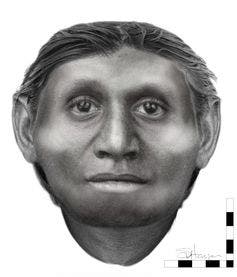Coincident with the much anticipated release of the new Lord of the Rings flick, a forensic anthropologist went through the painstaking process of reconstructing the face of the now famous Flores “hobbit”. The facial reconstruction shows a figure that looks a lot more modern than scientists would have thought.

A reconnstruction of the “The Hobbit’s” face, according to a forensic facial approximation. University of Wollongong
Homo floresiensis caused a wave of controversy when then hominid species was first discovered in Flores, Indonesia in 2003. Scientists engaged in a debate, with some claiming that the tiny 3 feet 6 inches tall specimen belongs to a new hominid species of its own, while others argued that the specimen was a diseased individual belonging to a more modern race.
The hobbit fossils were found in Flores’s Liang Bua Cave and dated to between 95,000 and 17,000 years ago. Multiple other skeletons, although incomplete, have been found since the initial discovery, yet still H. floresiensis stands under the shadow of doubt as a whole species.
What interesting to note is that the hobbit made tools on par with the humans of the time, despite having a brain 1/3 their size and lived during a time when all other hominins had died out (except H. sapiens).
Regardless, Dr Susan Hayes, a Honorary Senior Research Fellow at the University of Wollongong and specialist facial anthropologist, used an exact replica of the Flores Hobbit skull and built fat and muscle tissue around it. The reconstruction results are quite surprising, showing high cheekbones, long ears and a broad nose.
“She’s not what you’d call pretty, but she is definitely distinctive,” Dr Hayes said in a statement.
“She’s taken me a bit longer than I’d anticipated, has caused more than a few headaches along the way, but I’m pleased with both the methodological development and the final results.”
Darren Curnoe, a human evolution specialist at the University of New South Wales, said the face looked more modern than he expected.
“The bones are really quite primitive looking and look a bit like pre-humans that lived two or three million years ago but this new construction looks, to me, surprisingly modern,” he said.
“I think it’s really interesting to see a new approach founded in forensic science and it can actually progress the ways we can understand what Homo floresiensis looked like. What we have seen, until now, have been artistic interpretations, very beautiful ones, but I think this really takes it to a new level and gives us a more scientific and accurate view of what the hobbit looked like.”

Forensic facial approximation methods helped give an idea of how the muscle and fat intersected with the hobbit’s skull . (c) University of Wollongong
Indeed, H. floresiensis is an extremely interesting species, if that’s the case. Where exactly does it fit in the human evolutionary line is yet to be determine, and this is where anthropologists are currently channeling their efforts towards.
via The Conversation









